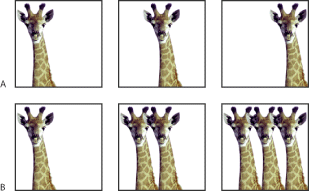Setting the frame disposal method
The frame disposal method specifies whether to discard the current frame before displaying the next frame. You select a disposal method when working with animations that include background transparency in order to specify whether the current frame will be visible through the transparent areas of the next frame.

Illustration of frame disposal methods: A. Frame with background transparency with Restore to Background option B. Frame with background transparency with Do Not Dispose option
The Disposal Method icon indicates whether the frame is set to Do Not Dispose ![]() or Restore to Background
or Restore to Background ![]() . (No icon appears when disposal method is set to Automatic.)
. (No icon appears when disposal method is set to Automatic.)
To choose a disposal method:
- Select a frame or frames for which you want to choose a disposal method.
- Right-click (Windows) or Ctrl-click (Mac OS) the frame thumbnail to view the Disposal Method context menu.
- Choose a disposal method:
- Automatic to determine a disposal method for the current frame automatically, discarding the current frame if the next frame contains layer transparency. For most animations, the Automatic option yields the desired results and is, therefore, the default option.
- Do Not Dispose to preserve the current frame as the next frame is added to the display. The current frame (and preceding frames) may show through transparent areas of the next frame. To accurately preview an animation using the Do Not Dispose option, preview the animation in a browser.
- Restore to Background to discard the current frame from the display before the next frame is displayed. Only a single frame is displayed at any time (and the current frame will not appear through the transparent areas of the next frame).
Note: Choose the Automatic disposal option when using the Redundant Pixel Removal optimization option, to enable ImageReady to preserve frames that include transparency.